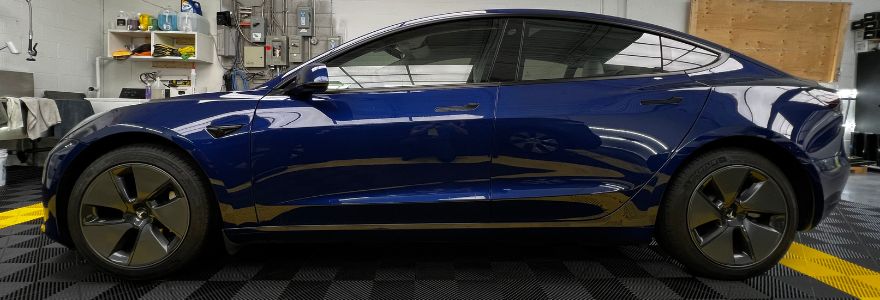If you’ve been looking into ways to protect your vehicle’s paint, you’ve probably come across the term ceramic coating. It’s become one of the most popular upgrades among car enthusiasts, detailers, and everyday drivers alike—and for good reason.
But what exactly is ceramic coating? And how does it work?
In this guide, we’ll break it down in simple terms so you understand what ceramic coating does, how it protects your vehicle, and whether it’s the right choice for you.
What Is Ceramic Coating?
Ceramic coating is a liquid polymer that is applied to your vehicle’s exterior surfaces. Once it cures (hardens), it forms a strong, transparent layer that bonds with your car’s clear coat.
Think of it like adding a glass-like shield over your paint—one that’s hydrophobic (repels water), scratch-resistant, and highly durable.
The main ingredient in most ceramic coatings is silicon dioxide (SiO₂), which is also found in natural materials like quartz and sand. When applied to your vehicle, it creates a chemical bond that enhances protection far beyond what wax or sealants can offer.
How Does Ceramic Coating Work?
Ceramic coating works at the molecular level to seal and smooth the surface of your vehicle’s paint.
Here’s what happens step-by-step:
-
Application: The coating is applied by hand in small sections using a soft applicator pad.
-
Bonding: As it cures, the coating chemically bonds with your paint’s clear coat, creating a semi-permanent layer.
-
Curing: Over a few hours (or days, depending on the product), the coating hardens into a clear, protective barrier.
Once cured, it becomes extremely hydrophobic, meaning water, dirt, and other contaminants have a much harder time sticking to the surface.
Key Benefits of Ceramic Coating
1. Unmatched Paint Protection
Ceramic coating protects your vehicle from:
-
UV rays that cause fading and oxidation
-
Bird droppings and bug splatter
-
Tree sap, road salt, and brake dust
-
Minor scratches and swirl marks
-
Chemical stains from acid rain or harsh cleaners
While it won’t prevent rock chips or deep scratches (that’s what Paint Protection Film is for), ceramic coating adds an impressive layer of resistance to everyday damage.
2. Hydrophobic Surface (Water Repellent)
One of the coolest features of ceramic coating is its hydrophobic properties.
Water, mud, and grime bead up and slide off easily, making your car easier to wash and faster to dry. Most of the time, a quick rinse or light hand wash is all it takes to keep your vehicle looking fresh.
No more stubborn water spots or baked-on bird droppings that take hours to remove.
3. Incredible Gloss and Shine
Ceramic coating enhances your vehicle’s appearance with a deep, mirror-like gloss. It doesn’t just sit on top—it brings out the richness and clarity of your paint.
Even on older cars, ceramic coating can revive dull paint and give it that just-detailed look.
4. Long-Lasting Protection
Unlike wax (which wears off in weeks) or sealants (which last a few months), a professionally installed ceramic coating can last 2 to 5 years, depending on the product and how it’s maintained.
Some high-end coatings even come with warranties of 5+ years.
5. Less Maintenance, Better Results
Because the coating resists dirt and contamination, you won’t need to wash your car as often. And when you do, it’s a lot easier—no scrubbing, no harsh chemicals, no endless buffing.
Less effort. Better shine. Longer-lasting results.
Is Ceramic Coating Right for You?
Ceramic coating is perfect for:
-
New vehicles you want to protect right from the start
-
Daily drivers exposed to harsh weather, road salt, and UV
-
Luxury or high-end vehicles that need long-term gloss retention
-
Anyone who loves a clean, shiny car without constant work
That said, it’s not a magical, set-it-and-forget-it solution. You’ll still need to wash your vehicle regularly and avoid abrasive cleaners. But overall, ceramic coating dramatically reduces the effort required to keep your car looking great.
What Surfaces Can Be Ceramic Coated?
While most commonly applied to paint, ceramic coating can also be used on:
-
Wheels and brake calipers (for easier cleaning)
-
Glass (to improve visibility and water beading)
-
Plastic trim (to prevent fading)
-
Headlights and taillights (to reduce yellowing)
Ask your installer about full-surface packages for maximum protection all around.
Ceramic Coating vs. Wax: What’s the Difference?
| Feature | Ceramic Coating | Wax |
|---|---|---|
| Durability | 2–5 years | 1–2 months |
| Protection | Strong chemical & UV | Mild |
| Hydrophobic Effect | Strong | Moderate |
| Gloss | Deep & reflective | Glossy, but short-term |
| Maintenance | Low effort | Frequent reapplication |
While wax is cheaper and easy to DIY, ceramic coating offers superior performance and long-term value.
Final Thoughts
Ceramic coating is one of the best ways to protect your vehicle’s finish while making it easier to clean and maintain. It offers long-lasting durability, next-level gloss, and real protection against the everyday elements that can dull or damage your paint.
Whether you’re a first-time car owner or a serious enthusiast, ceramic coating is a smart investment that pays off every time you hit the road.
Ready to protect your vehicle with ceramic coating?
Contact us today to learn more about our ceramic coating packages or book a consultation. We’ll help you choose the right solution for your car and lifestyle.


